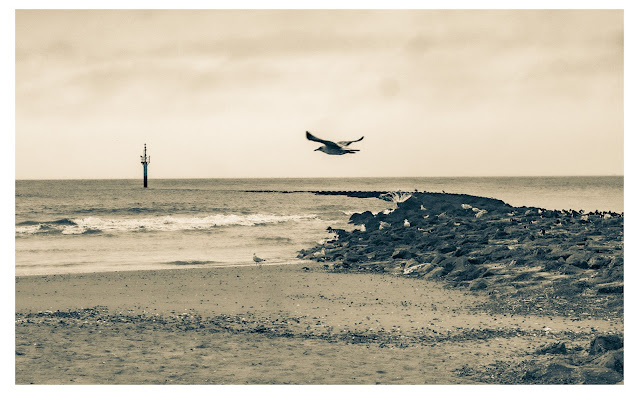With the year rapidly drawing to a close and the clocks going back an hour to prepare for the onset of winter, photographic opportunities are becoming limited, as the weather and good daylight can no longer be relied upon. So, I decided to make the best of what I had and jumped the train across the Mersey to New Brighton, on the top of the Wirral peninsula, overlooking the estuary. With a long history of smuggling and deliberate shipwrecking, the town has a rich and varied history, with secret tunnels running underground from the coast and legends of hidden treasures. New Brighton was once a popular Victorian holiday destination with fairground, pier and a large tower in the style of Blackpool. Favoured by Lancashire's industrial towns as a seaside destination, it enjoyed popularity for many years, until just after the First World War, the tower had to be dismantled and later the pier fell into disrepair. When the regular Mersey Ferry services ceased in the seventies, traffic to the town dwindled further. Over time, the tourist trade disappeared and the slump during the 1980’s hit the town hard. As a result, it became just another casualty of recession. However in recent years, it has had a significant facelift, with the seafront being remodelled and investment from businesses channelled into the area, resulting in a revival of interest. Efforts to clean the river have meant a return of wildlife and cleaner beaches and today New Brighton has a busy tourist trade once more.
The sea defences nearby are home to a surprising variety of birdlife, with Egrets, Cormorants and Shags, vying for the best position on the stonework.
Fort Perch Rock is largely made of sandstone and has been the subject of many attempts at restoration over the years, but is currently home to a small bar and cafe.
It’s walls are peppered with turrets and viewports and recesses for the ordnance, now long removed.
The rusting iron and red sandstone make for a wonderful contrast with the sea green weeds and mosses clinging to the sides.
Inside is a small atrium with various doors and corridors running off, storing the remnants of earlier attempts to put the place to use, such as an Aviation Archeology Museum, Escape room event space and a comedy club. Mostly the area seems to used as a storage space for scrap and old hardware. Randomly stored on the deck was this Hawker Hunter Trainer cockpit, along with various shells and possibly a sea mine. Unfortunately, the museum was locked up and seemed to be permanently closed.
The estuary looks back towards Liverpool, with views of the thriving city and massive container port.
The huge dockside cranes at Seaforth are clearly visible from across the river and equally, the green dome of St Philip’s church can be seen from the Pier Head.






















Terrific photographs, lovely locations. Those dockside cranes are magnificent - there's nothing like a good industrial landscape. SFZ
ReplyDeleteThat looks like a great day out. I have always liked lighthouses. The Hawker Hunter cockpit is from a single-seat model, not one of the two-seat trainers. Hope it finds a good home, out of the weather and sea air.
ReplyDeletea lovely walkabout with your camera Bill in a captivating place. I really must go there. Reminds me of Cape Cod with the lighthouse. I'm glad its coming back to life as a place to go.
ReplyDeleteSome lovely compositions in a place with a rich maritime history.
ReplyDelete